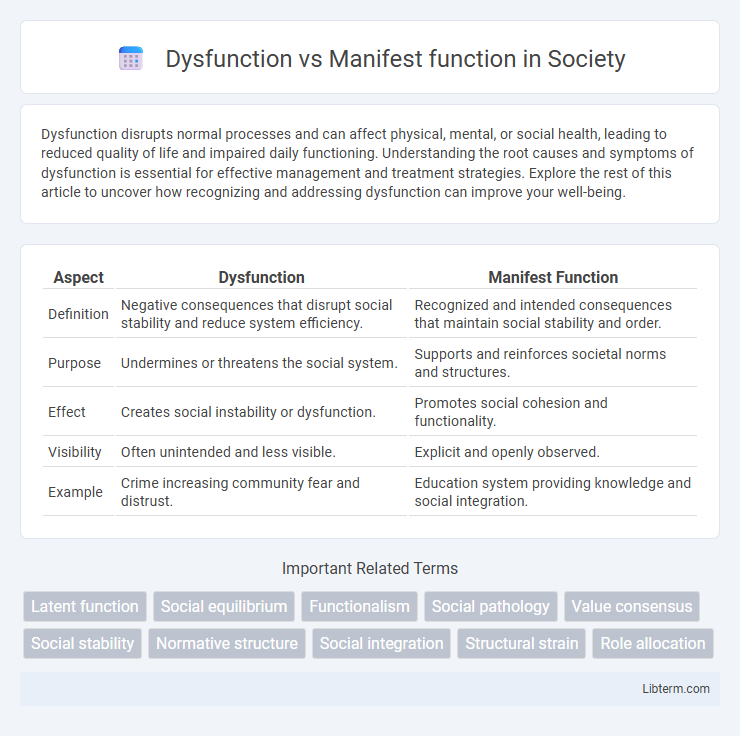Dysfunction disrupts normal processes and can affect physical, mental, or social health, leading to reduced quality of life and impaired daily functioning. Understanding the root causes and symptoms of dysfunction is essential for effective management and treatment strategies. Explore the rest of this article to uncover how recognizing and addressing dysfunction can improve your well-being.
Table of Comparison
| Aspect | Dysfunction | Manifest Function |
|---|---|---|
| Definition | Negative consequences that disrupt social stability and reduce system efficiency. | Recognized and intended consequences that maintain social stability and order. |
| Purpose | Undermines or threatens the social system. | Supports and reinforces societal norms and structures. |
| Effect | Creates social instability or dysfunction. | Promotes social cohesion and functionality. |
| Visibility | Often unintended and less visible. | Explicit and openly observed. |
| Example | Crime increasing community fear and distrust. | Education system providing knowledge and social integration. |
Understanding Dysfunction and Manifest Function
Understanding dysfunction involves recognizing unintended negative consequences that disrupt social stability, such as increased crime rates harming community cohesion. Manifest functions refer to the intended and recognized outcomes of social institutions, like education providing knowledge and skills. Differentiating between dysfunction and manifest function clarifies how social systems maintain balance despite occasional adverse effects.
Definitions: Dysfunction vs Manifest Function
Dysfunction refers to the negative consequences or disruptions a social structure or institution causes within society, undermining stability and social order. Manifest function denotes the intended and recognized positive outcomes of social actions or institutions that contribute to social stability and cohesion. Understanding dysfunction and manifest function helps analyze how societal elements maintain or challenge social equilibrium.
Historical Background and Theoretical Origins
Dysfunction and manifest function originate from the foundational work of sociologist Robert K. Merton, who expanded on Emile Durkheim's structural functionalism by distinguishing between intended and unintended social outcomes. Manifest functions refer to the recognized and intended consequences of social institutions, while dysfunctions denote the unintended negative effects that disrupt social stability. This theoretical framework emerged in the mid-20th century, providing a nuanced lens to analyze complex social systems and their multiple impacts on society.
Key Differences Between Dysfunction and Manifest Function
Dysfunction refers to the negative consequences or disruptions within a social system, whereas manifest function describes the intended and recognized outcomes of social actions or institutions. Key differences include dysfunction being unintended and harmful effects, while manifest functions are intentional and beneficial, highlighting the contrasting roles each plays in maintaining or challenging social stability. Understanding these distinctions is central to analyzing social phenomena from a functionalist perspective.
Examples of Dysfunction in Society
Dysfunctions in society disrupt social stability, such as rising unemployment leading to increased crime rates and social unrest. Another example includes pollution resulting from industrial growth, which harms public health and deteriorates living conditions. Educational system failures can also create dysfunction by limiting social mobility and perpetuating inequality.
Illustrations of Manifest Function in Social Structures
Manifest functions in social structures refer to the intended and recognized consequences of social institutions, such as education providing knowledge and fostering social skills. For example, schools explicitly teach literacy and numeracy, preparing students for the workforce and civic participation. This contrasts with dysfunctions, which are unintended disruptions or negative consequences that hinder social stability.
Interrelationship Between Dysfunction and Manifest Function
Dysfunctions are unintended negative consequences that disrupt the stability of social systems, while manifest functions are the intended and recognized outcomes serving the system's equilibrium. The interrelationship between dysfunction and manifest function highlights how a single social practice or institution can simultaneously fulfill intended purposes and generate unforeseen harmful effects. Understanding this dynamic reveals that manifest functions often coexist with latent dysfunctions, influencing social change and adaptation processes.
Impacts on Social Systems and Institutions
Dysfunctions disrupt social systems by creating instability, reducing efficiency, and undermining institutional norms, while manifest functions maintain stability and promote institutional goals through intended and recognized outcomes. Social institutions rely on manifest functions to sustain order and deliver expected benefits, whereas dysfunctions highlight unintended negative consequences that can lead to social change or conflict. Analysts examine dysfunctions to understand vulnerabilities within social structures and to address challenges impeding institutional effectiveness.
Real-World Case Studies: Dysfunction vs Manifest Function
In real-world case studies, manifest functions are the intended and recognized outcomes of social institutions, such as education imparting knowledge and skills to students. Dysfunctions refer to unintended or hidden consequences that disrupt social stability, exemplified by how educational disparities reinforce social inequality. Analyzing cases like the prison system reveals manifest functions of deterrence and rehabilitation, while dysfunctions include overcrowding and recidivism that undermine societal order.
Implications for Sociological Analysis and Policy Development
Dysfunctions disrupt social stability by producing unintended negative consequences that hinder societal equilibrium, while manifest functions represent the intended and recognized outcomes that contribute to social order. Understanding these distinctions enables sociologists to critically assess social institutions and policies, identifying areas where interventions may mitigate harmful effects or reinforce positive functions. Emphasizing both dysfunctions and manifest functions enriches policy development by ensuring comprehensive analysis of social dynamics and promoting sustainable, equitable solutions.
Dysfunction Infographic

 libterm.com
libterm.com